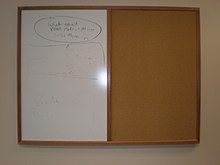|
Whiteboard
  A whiteboard (also known by marker board, dry-erase board, dry-wipe board, and pen-board) is a glossy, usually white surface for making non-permanent markings. Whiteboards are analogous to blackboards, but with a smoother surface allowing for rapid marking and erasing of markings on their surface. The popularity of whiteboards increased rapidly in the mid-1990s and they have become a fixture in many offices, meeting rooms, school classrooms, public events and other work environments. The term whiteboard is also used metaphorically in reference to features of computer software applications that simulate whiteboards. Such "virtual tech whiteboards" allow one or more people to write or draw images on a simulated canvas. This is a common feature of many virtual meetings, collaborations, and instant messaging applications. The term whiteboard is also used to refer to interactive whiteboards. History  It has been widely reported that Korean War veteran and photographer Martin Heit and Albert Stallion, an employee at Alliance, a leading flat rolled steel sheet supplier should be credited with the invention of the whiteboard in the 1950s. Heit and Stallion may have popularized and/or perfected whiteboards, but in reality the history of whiteboards long precedes them. A thorough examination of the invention of whiteboards reveals the concept was introduced two decades earlier by mechanical engineer Paul F. Born who installed one in a classroom in Elgin, Ill., in 1937.[1] Born was the head of the district's school board at the time.  Whiteboards became commercially available in the early 1960s, but did not become widely used until 30 years later. Early whiteboards needed to be wiped with a damp cloth and markers had a tendency to leave marks behind, even after the board was erased. [2] In 1974, whiteboards were proposed as additional equipment for Soviet schools.[3] Dry-erase markers for whiteboards were invented in 1975.[4] Whiteboards began being commonly used by businesses in the early 1990s.[5] They became more common in classrooms during the 1990s due to concerns over health problems in children with dust allergies and the potential for chalk dust to damage computers. By the late 1990s, about 21% of American classrooms had converted from chalkboards to whiteboards.[6] TypesThe first whiteboards were very expensive and were made of an enameled steel. Cheaper versions were then produced, including laminated chipboard, high-pressure laminates, and steel boards with a matte-finished or glossy white, usually polyester or acrylic coating. Enameled whiteboards, also referred to as porcelain and sometimes glass boards, have the advantage that markings can be erased completely; other materials tend to become stained over time. Enameled boards are more expensive and less used in commercial environments, but in more demanding environments with heavier use, such as educational establishments, porcelain boards are considered superior.[clarification needed] Other types of dry marker boards are also available, such as high gloss vinyl and coated paper, which can be rolled up, high-density two-part high gloss paints, glass and coated acrylics and polypropylene magic whiteboards which use static electricity to cling to walls, windows, and doors. Clear marker surfaces, made of glass (matte or glossy) or specially coated acrylic, became available around the mid-2000s. They are generally manufactured from technical glass, e.g. for monitor screen filters, which is optically coated. Adhesive whiteboardsWhiteboard material can be bought in rolls, sheets, and pre-formed boards. Adhesive whiteboards come in either a sheet or a roll and feature a stick back enabling the user to create a custom size board or project with the material. Although adhesive whiteboard material does not come in a thick, hard glass or painted steel plate, the melamine allows for a flexible material while preserving the high-quality whiteboard attributes of other surface materials.[7] Adhesive whiteboards allow for custom projects such as dry erase wall calendars, whiteboard tables, cupboard grocery lists, indoor games for kids, and more.[8] Erasable markerOne type of whiteboard pen (also called a whiteboard marker or dry erase marker) was invented by Jerry Woolf of Techform Laboratories and later patented by Pilot Pen in 1975.[9] It is a non-permanent marker and uses an erasable ink that adheres to the writing surface without binding to or being absorbed by it. Applications range from temporary writing with acetate sheets (for use with overhead projectors) to whiteboards and similar glossy surfaces. The erasable ink does not contain the toxic chemical compounds xylene and/or toluene, unlike permanent markers. Surface materialsThere are six types of materials commonly used for whiteboard surfaces:
See also
ReferencesWikimedia Commons has media related to Whiteboards.
|